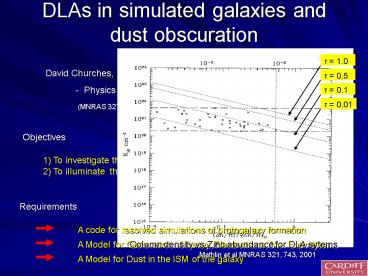DLAs in simulated galaxies and dust obscuration - PowerPoint PPT Presentation
Title: DLAs in simulated galaxies and dust obscuration
1
DLAs in simulated galaxies and dust obscuration
t 1.0
David Churches, Mike Edmunds, Alistair Nelson
- Physics Astronomy, Cardiff
University
t 0.5
t 0.1
t 0.01
(MNRAS 327, 610, 2001 347, 1234, 2004)
Objectives
1) To investigate the plausibility of
proto-galaxies as the originators of DLAs 2) To
illuminate the effect of dust obscuration on DLA
count statistics
Requirements
A code for resolved simulations of protogalaxy
formation
A Model for Generation of Heavy Elements via Star
Formation
Column density vs Zinc abundance for DLA sytems
Mathlin et al MNRAS 321, 743, 2001
A Model for Dust in the ISM of the galaxy
2
Aim of the Simulations
CDM N-body simulation of a 240 Mpc box (Virgo
consortium ApJ 499, 20, 1998)
This is NOT the aim of our simulations
Our Aim is to simulate the detailed development
of structure and column density at the level of
individual galaxies
3
Galaxy Formation Code
Peter Williams - Joint Astrophysical Institute,
Shanghai Normal University
- Tree-Code/SPH with 1/(r e)
potential - Parallelised using mpi
- - both particle pushing and tree building
- Individual Particle Timesteps
- Fully dynamic Kernel Radius
- Star Formation via a Schmidt Law ( SF
k ?1.5) - Isothermal Equation of State
(Williams, Churches Nelson ApJ 607, 1, 2004)
4
Sample Run - Initial ConditionsWilliams
Nelson, A.A. 2001, 374, 860.
- Mass 5x1011 M? 90 non-baryonic
DM, 10 baryonic gas - Initial Radius Ri 175 kpc
- initially solid body rotation with O 0.16 /
Gyr (? 0.06) - initially in Hubble expansion with Vradial
Hi R , Hi 560 km/sec per Mpc - sound speed 7.5 km/sec , e 175 pc
- 33552 gas , 33401 DM particles, finally 46016
star particles
Dark Matter
Gas
5
Gas, Star DM movies
(http//www.cf.ac.uk/pub/Alistair.Nelson/index.htm
l)
gas only face-on
all components face-on
all components edge-on
gas column density face-on
6
gas
stars
dark matter
Sample run final state after 9 Gyrs
In addition to Morphology, the model galaxies
also match observations quantitatively
7
First - Spiral Shocks
Another simulation
Gas velocity near central object showing shocks
Isothermal shock Pre-shock velocity 38
km/s Sound speed 10 km/sec ?Mach number
3.8 Density jumps by a factor of 20 Equivalent
to Mach number 4.5
8
Other Galaxy Properties
DM
- Rotation Curve
- Density Profiles
- Star Formation Rates
Gas x vs vy
- final stellar mass 3.75x1010 M? - final gas
mass 1.25x1010 M?
Stars
Gas
9
Generation of heavy Elements
We apply the simple model (Pagel Patchett
MNRAS 172, 13, 1975)
Where Z Metallicity ?g gas
density p fraction of the new stellar
mass returned to ISM in
heavy elements a fraction of new
stellar mass locked up as long- lived
stellar remnants and dS/dt rate of
SF per unit volume
This formula is applied to all the gas particles,
which carry the metallicity Z in the galaxy
Z vs time, using Z23(O/H) (Pagel et al MNRAS
255, 325, 1992)
Z vs time, and radius using Z23(O/H) (Pagel et
al MNRAS 255, 325, 1992)
10
Mini Survey of 5 Models
First the column densities and Zinc abundances
through vertical sight lines through the gas
discs of the models were calculated
On 16x16 grid 30 kpc square
11
Mini Survey of 5 Models
Model parameters used - Mass (1011 M?)
5 5 5 2.5 10 Spin Parameter ?
0.06 0.09 0.12 0.09 0.09
a
b
For each model the Column densities and
Zinc abundances were calculated at 4 times from
the start of the calculation
for the 5x1011 M ? case time
(Gyears) redshift a 1 2.2 b 2 1.3 c 3 0.8 d
5 0.4
c
d
12
Mini Survey of 5 Models
observations
The models overlap the observations, but occupy a
larger region, with many high column density
sight lines But these have t 0.5, which means
that they may not be observed (Pei Fall Ap J
,1995)
All the models at t 1 and 2 Gyears
13
Dust Model
The amount of dust is based on the metallicity
From Mathlin, Baker, Churches, Edmunds MNRAS,
321, 743, 2001 Edmunds Eales MNRAS, 299, L29,
1998.
The Optical Depth t for metallicity Z is given by
-
Where Ng gas column density
14
Varying inclination angle
The sight line survey was repeated for 2 other
angles of incidence
80o
Fraction of sight lines with t 0.5 or 1.0 as a
function of time for the M 5x1011M? case
60o
0o
Conclusions- 1) The results support the idea
that DLAs originate in galaxy disks at different
stages of evolution 2) Any observational survey
which counts the number of DLAs needs to
recognise that up to a significant fraction of
them may not have been detected
15
The End
16
(No Transcript)































